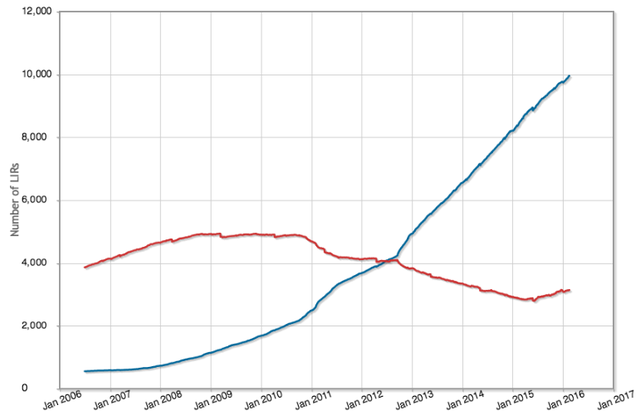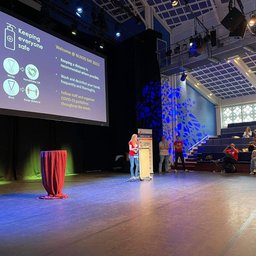This week, the RIPE NCC saw a milestone as the 10,000th Local Internet Registry (LIR) received IPv6 addresses. The first block of IPv6 addresses was allocated from IANA to the RIPE NCC in 1999, so we have been distributing IPv6 addresses for 17 years. In those years we have seen interesting policy developments, making it easier for LIRs to obtain enough IPv6 to satisfy their needs. In this article we track the policy developments that have made it progressively easier for LIRs to get the IPv6 they need.
The distribution of IP addresses is the core task of the RIPE NCC as a Regional Internet Registry (RIR), hitting the 10,000 mark is a good time to reflect on IPv6 policy developments.
Figure 1 shows that the number of those LIRs that have IPv6 (blue) has increased significantly compared to those LIRs that don't yet have IPv6 resources (red). Since the last /8 policy was changed in 2015 to not contain an IPv6 allocation requirement anymore, we see the number of LIRs with IPv6 continues to grow. However, you can also see the number of LIRs that don't have IPv6 has started to increase slightly.

Figure 1: Number of LIRs in the RIPE NCC service region that have IPv6 resources (blue line) and those that don't (yet) have IPv6 resources (red line)
You can find the most up-to-date graph on the Statistics Dashboard .
To see the full picture, you can look at Figure 2 below. It shows the total of all IPv6 allocations and assignments made by the RIPE NCC since 1999 1 .
You can see the impact some policy changes had on the distribution of IPv6 address space. We will walk you through these policies below.

Figure 2: Total IPv6 allocations and assignments made by the RIPE NCC since 1999
Early 2000s
The initial allocations to the RIRs were defined in RFC 2928 and IANA allocated 2001:600::/23 to the RIPE NCC in 1999. When the RIPE NCC started to allocate IPv6 addresses to its members that same year, there was only a "Provisional IPv6 assignment and allocation policy document” , stating that a RIPE NCC member could initially get a /35 IPv6 allocation.
| 3 | 13 | 13 | 19 |
+----+----------+---------+---------------+
| FP | TLA | Sub-TLA | NLA |
| | ID | | ID |
+----+----------+---------+---------------+
Various aggregation levels as envisioned in the early IPv6 policy days (see RFC 2928)
2002
This changed in 2002 when the
first IPv6 policy document
was published. This was a joint policy with APNIC and ARIN. From that moment on, the minimum IPv6 allocation size to an LIR was a /32.
It is also interesting to note that at that point an LIR had to have a plan to make no less than 200 /48 assignments to endsites within two years. The LIR could also make /64 or /128 assignments. This initial requirement was
removed in July 2007
, causing an uptake in IPv6 allocation requests.
In 2002, the RIPE NCC was not distributing so called Provider Independent (PI) address space yet. Actually, the RIPE NCC service region was the last region to have finalised a policy about IPv6 PI addresses, mostly because of concerns for the global routing table. It took three years before the community reached consensus and it was only in May 2009 that the RIPE NCC made the first IPv6 Provider Independent assignment.
2008 - 2009
In 2008, a
policy was briefly
proposed
to allocate IPv6 to all RIPE NCC members, but this proposal was withdrawn because it didn't get enough support from the community.
A year later, in 2009, a policy was accepted to remove the requirement to announce the prefix as one single aggregated block in the global routing table. Again, this policy change led to an increase in IPv6 allocation requests.
2012
It was in 2012, when the
last /8 policy
came into effect that it became it mandatory to have IPv6 resources in order to receive a /22 from the last /8. From 2012 to 2015, we saw a large uptake in IPv6 allocation requests because of this policy.
Another interesting development was a
policy change in 2012
, where the initial IPv6 allocation size could be expanded to a /29 without additional justification. The idea behind this proposal was to help members implement IPv6 transitioning mechanisms, such as
6rd
, that needed a lot of subnets. Over the last years we have seen many LIRs expanding their /32 initial allocation to a /29.
2015
The "mandatory IPv6 allocation” policy
was changed in 2015
because the RIPE community felt it was not the task of the RIPE NCC to allocate “unneeded” IP resources. Since then, we see the number of IPv6 allocation requests remaining stable.
The most recent IPv6 policy change was introduced by a large enterprise and a government, showing that it is no longer only traditional ISPs that have an interest in IPv6.
Conclusions
It is interesting to see how the different policies over time had an impact on the distribution of IPv6 address space in the RIPE NCC service region. Current policies make it easy to request IPv6 addresses so there is no hurdle to take your first step in IPv6 deployment. The developments also show the benefit to the Internet community of getting involved in the Policy Development Process . Policies relating to IPv6 are discussed in the IPv6 Working Group and the Address Policy Working Group .
Footnote 1: The total number on this graph exceeds 10,000 because it includes IPv6 assignments to end users. Also some LIRs have more than one allocation or have assignments in addition to the allocation
.





Comments 0
The comments section is closed for articles published more than a year ago. If you'd like to inform us of any issues, please contact us.